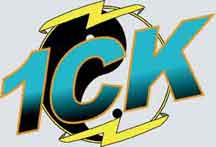I spent my 45th birthday in California at the home of Rick and Carin Howell. Rick "Ick" has been handcrafting skateboards for over 30 years (his first attempt was in shop class in high school in 1972.) He is truly an artist whose works in fiberglas and foam.
Rick was kind enough to pick me up at the airport in his new Ford sporting what can only be a unique and umistakable personal license plate:

Recently I ordered some new Icks from Rick and when I arrived the first thing I saw was the "Ick Workshop" where Rick wields his magic:

These wooden templates are the various shapes needed to accurately rout out the foam core necessary as the backbone for the boards. Whether it's a standard design or a custom (like mine,) it all starts with woodcraft.
On the wall next to the workbench are what could best be described as an "archive" of Icks both past and present. Rick has more skateboard history in his garage than you could find adding up all the skate treasures on the East Coast!

Laying on the table were the "rough layups" of two of my new boards. Identified as anything from the "diamond" to the "coffin," I prefer calling my shape the "Kite Board." I missed the chance to see Rick actually rout out the foam and lay on the glas, but I was happy seeing as much work had progressed as there was when I arrived:


The core is completely wrapped in glas with the excess still around the edges. The tops are a gorgeous mirror-finish but the underside is still "raw."

Although working with traditional materials, Rick is not afraid to innovate and do what's necessary to produce a product that is as contemporary as anything else on the market, if not a little more advanced. Rick is incorporating carbon fiber reinforcement "strips" in his board and add support but don't reduce or affect the "snap" that is the trademark of an Ick's flex:

Another example of Rick thinking ahead is the manner he reinforces his boards to support the mounting hardware. When routing out the foam, he pre-drills big 1/2-inch holes in the foam. Then when laying up the glas he fills these holes with solid fibreglas and carbon material. This provides solid footing for the hardware without the possibility of crushing the foam:

It's important, though, when ordering your Ick to be specific about wheelbases and drilling options. Just poking holes into the Ick later might miss the footing and you'll run the risk of crushing the board if you crank down too hard with the nut and bolt.
The mounting holes are prepared next. Rick has a custom tool for always getting the holes square and straight in his boards. He's quite proud of the little doohickey that Tay Hunt's father worked up for him many years ago. It's easy to use and works like a charm:

This closeup shows the guides and lock nut assembly that keeps it all in place on the slider bar:

After drilling, a grease pencil is used to draw out the shape of the board on top. The edge of the board is wider than the foam core, so getting this done accurately and square is imperative:

Rick is working on two boards at once. He was a little concerned when he realized he only had a RED grease pencil to scribe out a RED board. Fortunately, digging around the shop he found a black one and work proceded apace:

Next up is the rough cut. Rick moves outdoors for better ventilation and gets his grinding wheel tool to shape out the board. He runs the wheel just to the outside of the pencil line so as not to cut too deep into the shape:





After getting the rough shape, the sander comes out to finish off the edge down to the pencil line. Rick worked the sander like a sculptor works a chisel. He never let up, bore down or took his eye off the edge. To go all the way around both boards and create a perfect rail took about 10 minutes for each one:

Next up was sanding and finishing the bottom. Again, Rick worked both the sanding wheel and hand sanding with a finesse and ease I can't begin to match. When he was finished after less than 10 minutes on both boards the unpainted bottom and rails were perfect and without a flaw:


That night the weather and climate conditions were perfect for the final coat for the bottom of the boards. Rick is fanatical about no wind, no dust floating in the air, perfect humidity and ideal conditions for working on his boards. If it's not just right, he won't work. It seems in business today there is a motto of, "there's never enough time to do it, but there's always enough time to do it twice." Rick doesn't lets impatience get in the way of producing a stellar board. I should have these two beauties at the house by the end of the week:

Oh, and now Rick has to start all over again with two more for me: a medium flex and firm flex edition of his 37" swallow tail long boards. One will be California Gold and the other British Racing Green. I can't wait for the end result!



































